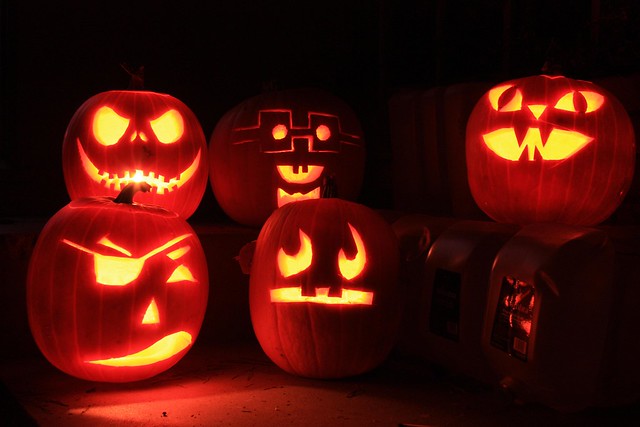In some places tonight is the night when children dress up in strange costumes and terrorize their neighbourhoods by demanding ‘treats’ and threatening ‘tricks’ if those ‘treats’ are not forthcoming. Or in other words, Halloween.
Although we in the UK tend to think of as an American import, the tradition of people dressing up and going from house to house and asking for food dates back to at least the 16th century in Ireland, Scotland and some other parts of the UK. It was known as mumming, guising or souling. People would sing a song or do some kind of trick, and receive a cake or other food in return [source].
Dutch equivalents of trick or treat are snoep of je leven (sweets or your life) or snoep of ik schiet (candy or I shoot), which sound rather more sinister than trick or treat [source]. Is this a common tradition in Dutch-speaking lands?
French equivalents include un bonbon ou un sort (a sweet or a spell) or farce ou friandise (practical joke or sweet) [source].
Is trick and treating, or something similar practised elsewhere? If so what’s it called.

In Mannin (the Isle of Man), it is known as ‘Hop-tu-Naa’, a corruption of Hop! Ta’n oie (‘Ho! It is the night’), since it marks the end of the old year in the Celtic calendar (November 1st, Laa Houney, is the start of the new year). Originally, people went from house to house with lanterns made from moots (turnips), singing the traditional song ‘Jinny the Witch’ and hoping for gifts. Nowadays, the British (? American) mode seems to have largely superseded the old ways, with pumpkins and all the associated paraphernalia. Atreih! (‘Alas!’)
Further to my previous post, I should have added that Hop-tu-Naa is cognate with the Scots word Hogmanay, which also refers to the last day of the Old Year. The origins of the Scots word are uncertain: see https://en.wikipedia.org/wiki/Hogmanay .
In Denmark Halloween has been celebrated for the past twenty years or so, but it is somewhat reminiscent of Fastelavn, a Danish tradition connected with Lent, which involves dressing up and a form of trick-or-treating called ‘raslen’ (rattling (a collection box)) or ‘boller eller ballade’ (buns or trouble).
More on Fastelavn here: https://en.wikipedia.org/wiki/Fastelavn
In the Netherlands, Halloween has grown in popularity over the past decades, but is definitely considered an American import phenomenon. Traditionally, the equivalent trick-or-treating events are Sint Maarten (November 11) in the northern parts of the country, and Driekoningen (“Three Kings”, i.e., Epiphany, January 6) in the south. Being from the north I don’t know much about the latter, but Sint Maarten involved going from door to door with a home-made lantern and singing songs in return for candy. No “scary” element is involved, nor dressing up. Nowadays, some children celebrate both events, because, hey: more candy, more better.